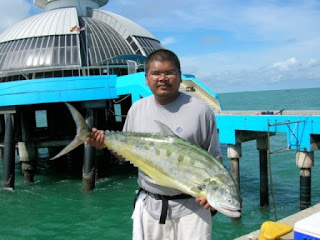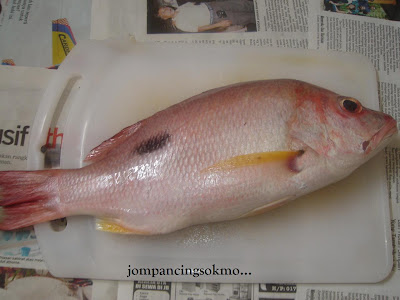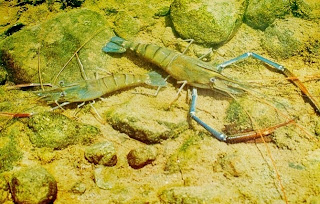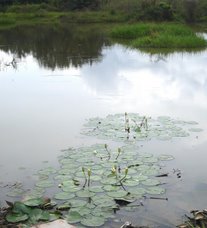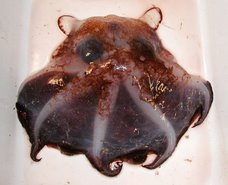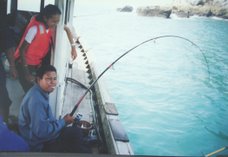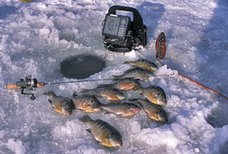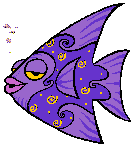
We have been there with 4 persons. We stayed at the Vilu Reef Lodge (
www.vilureef.com.). This lodge is very beautiful, nice beach bungalows and great food but the drinks are not includedI think that we have fly fished in one of the most beautiful destinations on earth…………...
Fly fishing from deserted islands. Each island had in the middle a dense jungle, surrounded by pure white beaches and by a coral reef. A fly fisherman’s dream. I organised a pilot-trip to see if we can find a new fly fishing paradise. We found a paradise, but the fly fishing was another part. From the beach you will see at the outer edges of the reef, everywhere Jacks, Trevallies hunting. Those fish stay most of the time in the reef and do not come hardly close to the beach. But not every island is equal. Sometimes the reef is very close and sometimes the reef is far away.
From the beaches we caught many small Groupers and Jacks and one Blue Fin Trevally. But the biggest fish are in the reef on along the " cuts " and "edges" on the blue side. We fished from a large traditional Dhoni normally used for diving purposes. We have fished from October 20th to October 27th at several small islands of the Dhaalu Atoll. We chose the islands and flats in relation to our main targets species to catch; Bonefish, Indian Ocean Permit, Barracuda. Jack and Trevally.
The decision what flat or island to fish from was made on a daily basis, mainly by ourselves using our knowledge and experience of similar tropical waters in the Caribbean and elsewhere and by studying the map of the Dhaalu Atoll after the first two days of fishing. During our stay we experienced the fly fishing in general as being difficult and though, because of the conditions that we were facing with and because of the lack of understanding of what fly fishing is all about at the Vilu Reef.
Fishing from deserted Islands: We were all hoping to catch a Bluefin Trevally from a beach of a deserted island. Everyday we saw them hunting far away from the island, in the corals or along the edges in the blue water along the reef. The only possibility of catching them was to swim with all your fishing gear from the beach to the reef and try to catch them by standing (!) on the coral reef and casting to the blue water edge. We experienced this method as being rather dangerous. You simply cannot tell to your clients that in order to catch a fish they have to swim to certain fishing spots.
The last days we spent mainly at Faandhu, a deserted island where the reef is closer to the beach. The fishing options on this particular island were somewhat better but far from ideal for fly fishing. From this island as elsewhere we caught mainly small Groupers between 15 - 25 cm and some tropical reef fish. The very few Bluefin Trevally and Jacks that we managed to hook were all lost in the sharp coral. All in all we truly missed a flat-bottomed boat better suited for this kind of fishing.
Fishing on the flats: We have fished some mornings and evenings on the flats around the local island nearby Vilu Reef where we thought to find Bonefish in large schools. All the flats around the Vilu Reef Lodge are to deep for Bonefishing by wading. We saw very few Bonefish at the local island nearby the Vilu Reef Resort and caught only one (!) during our entire stay. We caught numerous little Groupers and some big Garfish. We found it disappointing to see that the local people obviously don't care about their own environment. The shoreline is a mess and there is rubbish all over the place.
Fishing in the surf on the outer-reef of the atoll: The first day we went to the Sixteen Sandbanks, sixteen deserted islands in a row……….. We tried the flats for Bonefish first, but saw not a single fish. Then we spotted a lot of Jacks and Trevallies hunting in the blue water near the outer edges of the reef. Our video – man fished from the reef over the surf with very heavy spinning gear (not fly fishing) and succeeded in catching some nice fish.
The only possibility left was to cast from a boat in the blue water in the direction of the reef, trying to keep a hooked fish out of the coral reef and playing it in deeper water, with less chance of loosing the fish. However, this can only be done from open flat-bottomed boats, that are suitable for drifting close to the reef. Such boats allow a fly fisherman to cast easily with long fly lines to stalk and hunt the fish. A maximum of two fly fishermen and a guide by the outboard motor is the limit for fishing in the described way. Unfortunately such boats are not yet available at the Vilu Reef Resort.
So we had to make do with the Dhoni. The Dhoni is a nice comfortable boat for transporting passengers but not really a fishing machine. It is to heavy and to large to fish without any problems along the reef in the blue water. It has a roof, making it difficult to hook a fish from a certain distance. Fly fishing is impossible from a Dhoni, because you can not make a decent cast, but the people who had spinning rods, tried to cast along the reef.
The results : we lost one big fish in the coral reef and could not get it out, because the Dhoni could not get close enough to where the fish was stuck. At the end of our stay we lost a fight with a big fish because the Dhoni was not able to turn quickly enough. Another method of fishing can be trolling a lure or an artificial fly, but this is not what we consider to be fly fishing in the real sense of the word. The crew on board was very helpful but they are truly not fly fishing guides. Neither do they have any basic understanding of sport fishing. They know how to get to some of the islands and they know how to drop us off there, but they are certainly not fishing guides. We do realise of course that the staff of the Vilu Reef Resort is not familiar with this kind of sport fishing.
I think this summarize will give you a good impression. The area is unbelievable, but the fishing is tough, but very rewarding if you can catch a Trevally or a big Jack in these circumstances. But I like to be honest with you, and these were the results of our stay at the Vilu Reef. Resort, Dhaalu Atoll. However…………. Sun Travel, Maldives is busy to build a new lodge on a deserted island calledOlhuveli. Olhuveli is located in the South Male Atoll. This lodge is located at very huge lagoon, that is stretching out for more than 10 km…………
The management of Olhuveli told me that all the gamefish are swimming in the lagoon, like Permit, Bluefin & Giant Trevally, Barracuda and Jacks. They have boats and guides that can bring into and even outside the lagoon. I did email them also some pictures of Bonefish and they told me that they will find out it these fish are there. If you are interested I can give you a really good price if you consider this is as a pilot – trip. In return I like to receive a full report after your stay.
Please email me at tropical@castel.nl if you are interested in fishing the first in this maybe new fishing paradise. After reading this report, please check my new update at
www.tropicalflyfishing.com. I am looking forward to your answer.
Best Regards, Theo Huizing, Tropical Fly Fishing

















